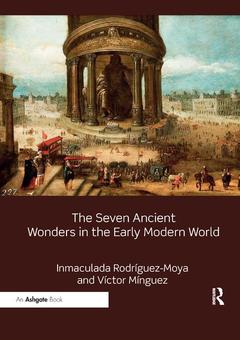The Seven Ancient Wonders in the Early Modern World
Auteurs : Rodríguez-Moya Inmaculada, Mínguez Víctor

The Seven Wonders of the Ancient World have had a lasting impact upon the intellectual landscape of the post-classical world. As well as provoking historical debate and reflection, they have proved an enduring yardstick by which succeeding generations have measured the architectural and cultural accomplishments of their own eras. Focusing particularly upon the Renaissance and Baroque periods, this book looks at how the Wonders of the World were represented in art, architecture and sculpture, and the ways that European courts could evoke them as a useful image of power. Within this artistic culture, special attention is paid to the recreations and constructions generated between the fifteenth and eighteenth centuries in the sphere of ephemeral art, especially those linked to court celebrations in the principal European states. This approach provides a framework to analyse and evaluate the claims of other European Renaissance and Baroque architecture to Wonder status, an approach bolstered by the use of the Palace of El Escorial as a case study of a modern ?Eighth Wonder?.
CONTENTS
ACKNOWLEDGEMENTS
PROLOGUE. Renaissance, Apocalypse and Wonders.
- THE INVENTION OF THE WONDERS. Characteristics of the wonders. The geography of the wonders. The classical and medieval lists. The Renaissance and Baroque taste for lists. The artistic series. The contemporary wonders.
- THE COLOSSUS OF RHODES. The myth of the Giant and its artistic depictions. A Colossus on the island of Rhodes. Imperial Colossus. Humanist evocations, between narrative and myth. The Baroque and the ephemeral Colossus. The last Baroque Giant, the Ribera Colossus. The artistic continuity of the Colossus.
- THE LIGHTHOUSE OF ALEXANDRIA. The city of Alexandria. The story and myth of the lighthouse in Antiquity. The lighthouse in medieval times: Islamic and Christian revivals. Artistic evocations in modern culture. Recreations in Enlightenment and French Revolution architecture. Skyscrapers as lighthouses.
- THE TEMPLE OF ARTEMIS AT EPHESUS. The legendary foundation of the city. The first temples of Diana. The fire and reconstruction. Ephesus under Rome. Images in Antiquity. Christianity at Ephesus. Renaissance and Baroque reconstructions. The destruction of the temple and its fame.
- THE MAUSOLEUM OF HALICARNASSUS. Mausoleum and Artemisia II of Caria. Architecture and sculpture. The mausoleum reborn. A new Artemisia: Catherine de Medici. She was his tomb.
- THE STATUE OF JUPITER AT OLYMPIA. Grandeur and majesty. Phidias. The medieval form of divine majesty. Jupiter and the image of power. Ingres and the Olympian-style Napoleon.
- THE HANGING GARDENS OF BABYLON. The lament of the banished. Paradises lost. The excavation of Babylon. From Semiramis to Nebuchadnezzar II. The myth of the Tower of Babel in the Renaissance. Baroque evocations of the Hanging Gardens. Saint Germain at Laye, Schönbrunn and Sanssouci.
- THE PYRAMIDS OF EGYPT. The birth of Egyptomania. Obelisks in Rome. Horapollo and the Renaissance fascination for hieroglyphics. Symbolic and Kircherian worlds. Pyramids and American archaeology. Pyramid-shaped mausoleums in the Baroque period, the Enlightenment and utopian architecture. Napoleon and the beginning of Egyptology. Vivant Denon at Thebes. Orientalism.
- EL ESCORIAL. A NEW WONDER IN THE RENAISSANCE. Idea and construction. The myth of the Eighth Wonder. The construction of El Escorial. The fame of the Eighth Wonder. Phillip IV and El Escorial. The destruction of 1671.
BIBLIOGRAPHY
INDEX OF ILLUSTRATIONS
Inmaculada Rodríguez-Moya is Assistant Professor in the University Jaume I, Spain. Her research has followed four lines of investigation: Iconography of Power, Colonial Art, Emblem Studies and Urbanism History. That research has been published in the form of two peer-reviewed and awarded monographs: La Mirada del virrey (2003) and El retrato del poder en México, 1781–1867 (2006), seven co-authored monographs, including Himeneo en la corte (2013), along with edited volumes, articles and contributions.
Víctor Mínguez is Full Professor in the University Jaume I, Spain. His research has followed three main lines of investigation: Images of Power, Emblematic Art and Latin American Art. His main research monographs are: Los reyes distantes (1995), Los reyes solares (2001) and La invención de Carlos II (2013); and, with Inmaculada Rodríguez-Moya, Himeneo en la Corte (2013) and Napoleón y el espejo de la Antigüedad (2014).
Date de parution : 05-2019
17.4x24.6 cm
Disponible chez l'éditeur (délai d'approvisionnement : 14 jours).
Prix indicatif 50,12 €
Ajouter au panierDate de parution : 03-2017
17.4x24.6 cm
Thèmes de The Seven Ancient Wonders in the Early Modern World :
Mots-clés :
Baroque; Europe; Renaissance; ancient; architecture; buildings; early modern; kings; monarchs; monuments; power; princes; queens; royalty; wonders of the world



